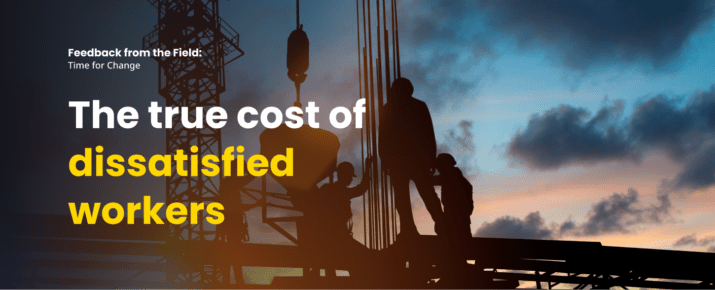Vaccinated customers: is confidence returning?
Feedback From The Field | Industry Trends | SafetyCulture News | By | 18 Aug 2021 | 4 minute read

This year, SafetyCulture teamed up with national survey organization YouGov to survey over 1000 Americans to gauge comfort levels as America reopens.
The majority of those surveyed would be comfortable in sharing their vaccine status. More so than that, 43% of Americans said they would have increased trust in organizations that require or request all entrants to share their inoculation status*.
What does this tell us about relaxing restrictions? Well, confidence may take some time to grow.
For businesses, agility is key
Over 50% of the American population are fully vaccinated, but new variants are now changing the game. This means that restrictions that were removed previously may come back into force like we have seen in multiple areas of the US and Australia.
We now never know what to expect – so that means businesses must remain agile, even with vaccines becoming more widespread.
Safety is still paramount
Despite the new level of safety, there is still some resistance to fully engaging with businesses. 24% of those we surveyed said they would still feel uncomfortable about staying in a hotel, and 25% would feel uncomfortable visiting a bar or restaurant*.
Most customers still want to wear masks inside public places (64%) and more than one in three (36%) said they will have some discomfort visiting businesses that have relaxed COVID-19 safety precautions*.
With the reluctance to go back to how things were, how can businesses implement safety standards for employees and customers?
Relaxing restrictions slowly
Clear and manageable safety processes are critical to a successful reopening that lasts.
Even if your customers are vaccinated, make sure that you’re continually communicating about your hygiene standards. This will establish a firm foundation of continued loyalty.
As our survey shows, even once vaccinated, customers still feel uncomfortable – so it’s important to manage expectations according to the industry you’re in.
Top tips to make safer spaces for everyone
Construction
In construction, it’s easy to work with large teams of people. Reduce the number of people each person has contact with by using ‘fixed teams or partnering’ or ‘cohorting’ (so each person works with only a few others).
If you’re going to someone else’s home to work, for example to carry out construction or repairs, it’s wise to communicate with households before any visits, to discuss how the work will be carried out to reduce risk for all parties.
Construction projects are rarely completed end-to-end by a single business. Often the principal contractor must source certain types of specialized work from subcontractors. This also means they are responsible for onboarding, training, and ensuring the continuity of worksite safety mechanisms across the lifecycle of the project for all of their contracted parties.
Subcontractor adherence to safety procedures can be easily tracked and evaluated with a simple, standardized checklist. With digital checklist platforms you’ll find that they have the ability to collect valuable information regarding safety compliance and general performance.
The manual and project-focused aspect of construction creates complexities when it comes to workforce management. Managing dispersed workers and revolving groups of contractors on-site can increase project risk, impact productivity, and reduce efficiency.
These challenges mean there is a need to enhance the responsiveness of training systems to meet a flexible work environment. Leaders must improve access to training and skills development for all teams — whether they are made up of permanent workers or subcontractors.
Facilities Management
Implement a strict cleaning routine for shared facilities via digital checks, and ensure that items such as water bottles are single-use only.
One option to minimise human contact in high footfall areas is to use remote sensors. These can monitor the temperature conditions in the room, and can be controlled from the comfort of home to avoid any risk of staff entering a contaminated building.
Where possible, encourage ventilation of areas. This may mean holding sports classes outside, or keeping the windows open before a meeting takes place in a room.
Site managers also need real-time visibility of what’s happening across different teams on-site at any given time, with the ability to communicate fluidly with workers and contractors from a distance. The ability to spot and address issues before they escalate into incidents or derail project timings is critical, even when managers aren’t physically on-site.
Events
Stay up to date with the latest COVID-19 cases in the weeks and days leading up to your event. Have contingency plans, just in case someone in your team or your guest speaker gets a notification that they have to self isolate.
Set up your event to decrease human contact on certain touchpoints. Use QR codes or an online presence to check in to your event, and communicate remotely wherever possible when conducting risk assessments – which can also be done digitally.
Where do your audience congregate online and physically? Distributing posters in high footfall areas and social media posts at the most engaged times of day will ensure your customers and staff are kept informed on a need to know basis. Check pre-scheduled posts for accuracy to make sure all of the information is up to date before they go out.
By making checklists and graphics collaborative, your team can easily update guidelines at a moment’s notice, refining your safety message as the COVID-19 rules change. Real time updates allow for communication to be prepared as a live government briefing is announced.
Hospitality & Retail
Safety doesn’t stop in the kitchen or store front. When guests enter venues, use an online form to let guests check in to hospitality venues, capturing their contact details and making sure you’re limiting human interaction.
In busy spaces like bars, implement screens or barriers to separate people from each other. For staff, you can also use back-to-back or side-to-side working, instead of face-to-face, especially if you have a high trafficked area.
With the pivot towards home delivery for many food outlets, it’s essential to equip delivery fleets with the right PPE and training.
Manufacturing
Carrying out a robust risk assessment with full workforce involvement (of recognized safety representatives or relevant employee safety representatives) will identify the practical measures that can be put in place to minimise the spread of the virus at a workplace level.
As manufacturing can have a high volume of staff, employers should ensure that communication with staff on COVID-19 risks and measures for preventing transmission are refreshed to take account of any updates and ensure levels of knowledge and understanding are maintained.
Want to read more? Here’s the full survey.
SafetyCulture is helping thousands of businesses navigate the pandemic. Check out more of our customer stories and see how they’re supercharging their operations with our COVID-19 response hub.
* All figures, unless otherwise stated, are from YouGov Plc. Total sample size was 1198 adults in 2020 and 1000 adults in 2021. Fieldwork was undertaken between 24th – 25th June, 2020 and 7th-8th June 2021. The surveys were carried out online. The figures have been weighted and are representative of all U.S. adults (aged 18+).
Important Notice
The information contained in this article is general in nature and you should consider whether the information is appropriate to your specific needs. Legal and other matters referred to in this article are based on our interpretation of laws existing at the time and should not be relied on in place of professional advice. We are not responsible for the content of any site owned by a third party that may be linked to this article. SafetyCulture disclaims all liability (except for any liability which by law cannot be excluded) for any error, inaccuracy, or omission from the information contained in this article, any site linked to this article, and any loss or damage suffered by any person directly or indirectly through relying on this information.





